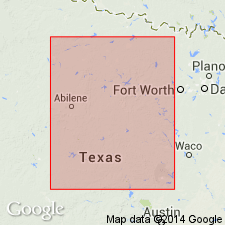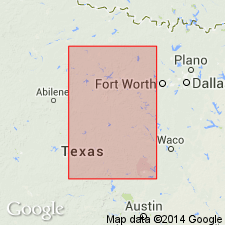
- Usage in publication:
-
- Pueblo limestone member
- Modifications:
-
- Original reference
- Dominant lithology:
-
- Limestone
- AAPG geologic province:
-
- Bend arch
Summary:
Pg. 133-145. Pueblo limestone member of Pueblo formation of Cisco [group]. Pueblo formation is bounded at top by Pueblo limestone [Camp Colorado limestone], which is yellow, fossiliferous, and impure. Near Red Bed line in Stephens County, central northern Texas, it changes to sand and loses its identity, but just below its horizon is a thin limestone abundant in MYALINA fossils [pelecypods], which characterize this bed. [Age is Pennsylvanian.]
Source: US geologic names lexicon (USGS Bull. 896, p. 1739-1740).

- Usage in publication:
-
- Pueblo limestone member†
- Modifications:
-
- Abandoned
- AAPG geologic province:
-
- Bend arch
Summary:
Pg. 40. †Pueblo limestone member of Pueblo formation. Replaced this name with Camp Colorado limestone member.
Source: US geologic names lexicon (USGS Bull. 896, p. 1740).
For more information, please contact Nancy Stamm, Geologic Names Committee Secretary.
Asterisk (*) indicates published by U.S. Geological Survey authors.
"No current usage" (†) implies that a name has been abandoned or has fallen into disuse. Former usage and, if known, replacement name given in parentheses ( ).
Slash (/) indicates name conflicts with nomenclatural guidelines (CSN, 1933; ACSN, 1961, 1970; NACSN, 1983, 2005, 2021). May be explained within brackets ([ ]).

